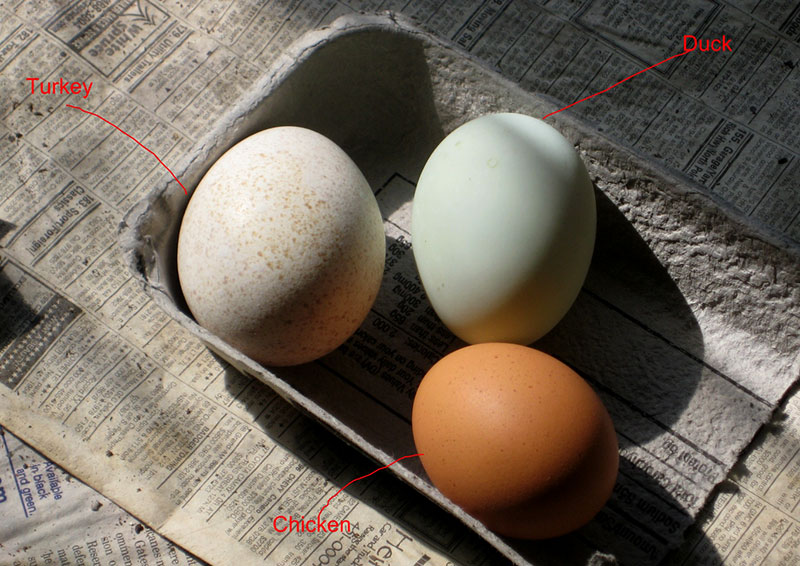
Many farmers begin raising poultry to get backyard eggs but don’t always know what to expect when they head out to the coop for the first collection. The laying patterns of poultry species vary, resulting in eggs of varying size, shape and color. From tiny, dotted quail’s eggs to the massive, green emu’s egg, all birds’ eggs that can be enjoyed fried, scrambled or over easy.
In this guide, we focus on the most common farm egg-layers: chickens, ducks and geese. The eggs you get from these fowl differ from one another, but all are full of flavor and nutritional benefits.
Chicken Eggs

Chickens are the stars of backyard egg production. They are the most commonly raised hobby farm animal, requiring little land or maintenance compared to other livestock, and are perfectly suited for both urban and rural keeping.
Chicken eggs are often brown or white, but some breeds lay beautiful pastel eggs in green, pink and purple shades. Bantam hens lay tiny eggs, but most chickens lay a standard size egg, approximately 2 ounces in weight. Shell color doesn’t affect the flavor of the eggs, but the diet the chickens eat can. Chicken eggs are a healthy option for your dinner (or breakfast) table, as they’re dense in nutrients and vitamins: They’re packed with healthy omega-3 fatty acids, and pasture raised eggs have especially high levels of vitamin E.
Chickens lay seasonally, with prolific production in the spring and summer and petering off during the dark months of winter or during a molt (the annual loss and replenishment of their feathers).
Duck Eggs

Mike Czyzewski/FlickrAlthough less common than chickens, ducks are another great option for the small-scale farmer seeking backyard eggs. They have limited space requirements and need only a small pool to keep their feathers clean and in order. Duck’s personalities seem to be always happy, and they’re great to have on the farm for slug control.
Duck eggs, like chicken eggs, are remarkably healthy. (The duck egg in the photo above is in the center, between a turkey and chicken egg.) Because slightly bigger, their vitamin and nutrient content per egg is higher—one duck egg is about the same serving size as 1½ chicken eggs. The yolk to white ratio for duck eggs is much higher than in chicken eggs, meaning their eggs hold together better and make a thicker batter when used in baking. Duck eggs are often white, but some breeds lay speckled eggs, brown eggs and even dark blackish-green eggs.
One of the great benefits to raising ducks for eggs: They are year-round layers. They barely slow down production during winter and the only challenge with ducks is finding their eggs, because they prefer a private spot on the ground to a nesting box.
Goose Eggs

The largest bird on our list, geese can also be great egg layers. The rarity of goose eggs, thanks to their seasonal laying and the fact they aren’t as popular as chickens and ducks, makes their eggs quite valuable and a bit of a conversation piece around the breakfast table. Geese aren’t as easy to raise as ducks and chickens because they require a larger pen and can be noisy.
If duck egg’s larger size means more nutrition, you can bet that this rule applies to the rich and delicious goose egg. Almost always white, goose eggs are huge, equivalent to three chicken eggs. The yolk of a goose egg is a darker, golden orange because their diets consist of foraged greens, not grain or insects. Similar to duck eggs, goose eggs have larger yolks and will thicken up a batter or mix.
Geese won’t lay at all in the fall and winter, but with a male goose on your farm, you can count on your female geese to lay from May through July or even September. This seasonality helps add to the goose egg’s allure, as you’ll only see them on the menu during certain months of the year.
No matter why you add poultry to your farm, the benefits of backyard eggs cannot be overlooked. With a few feathered friends you can reduce your grocery bill and enjoy the healthy benefits of farm-fresh eggs.




